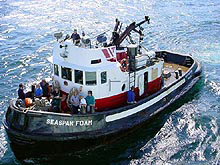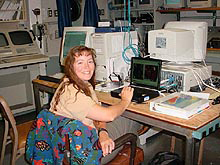
A tugboat from Victoria brought 6 new scientists out to meet us on the Thompson, for the next leg of our expedition.Click image for larger view.
Welcome Aboard!!!
July 24, 2002
Bill Chadwick
Geologist
Vents Program, Pacific Marine Environmental Laboratory, NOAA
This leg of our expedition (July 24-August 5) is a continuation of another leg that took place between June 28-July 11. On that first leg, we began our exploration of Explorer Ridge, a little-known, mid-ocean ridge in the northeastern Pacific where tectonic plates spread apart, submarine volcanoes erupt, and seafloor hot springs deposit exotic minerals and support unusual forms of life. The first leg concentrated on large scale mapping, including the bathymetry of the ridge, the distribution of hydrothermal plumes over the ridge, and high-resolution surveys near areas of active venting. Now we are returning to the site with a new suite of capable exploration tools, and in particular, the remotely operated vehicle named ROPOS. With ROPOS, we will be able to finally see the seafloor in the area where we collected survey data on the previous leg. The first leg gave us a host of promising exploration targets, and with ROPOS we will be able to investigate each one in turn. We are all excited to see what's down there. Stay tuned and you will find out too!
Kimberly Williams
Teacher at Sea

Kimberly Williams, the Teacher at Sea for the second leg of Submarine Ring of Fire Expedition. Click image for larger view.
Welcome to the next leg of the Submarine Ring of Fire Expedition. For those of you who would like to trace the first leg of our journey that ran from June 28th - July 11th please read through the previous logs on this Web site. Then be sure to check out our daily logs for the leg of the cruise that ran from July 14th - July 23rd and follow our exciting trail as we examined Axial Volcano and the New Millennium Observatory ![]() (NeMO).
(NeMO).
If you've just joined us, welcome. My name is Kimberly Williams. For 10 months of the year, I am a science and research teacher from Miller Place High School in New York. However, for three weeks this summer, my title has changed to "Teacher At Sea." I was selected to join the scientists and crew on this Ocean Exploration cruise and to share with you some of the exciting events that will occur in the Pacific Ocean aboard the Research Vessel Thomas G. Thompson.

A pod of Dall's porpoises greeted us as we approached Victoria for a personnel transfer. Click image for larger view.
Today, we left sight of Victoria, British Columbia, having transferred equipment and personnel, and we are now steaming off to the next phase of our expedition at Explorer Ridge. We are all anxious to arrive and begin exploring one of the least-studied seafloor spreading centers in the Northeast Pacific. Our explorations will be facilitated by the deep-sea research robot known as ROPOS (Remotely Operated Platform for Ocean Science), which can dive to a depth of 5,000 meters (almost three miles)! Among our many tasks, we'll be using ROPOS to investigate “Magic Mountain,” an active hydrothermal vent area that hasn't been extensively studied since its discovery in 1984. This is going to be some trip!
Sign up for the Ocean Explorer E-mail Update List.






















